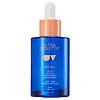What's inside
What's inside
 Key Ingredients
Key Ingredients

 Benefits
Benefits

 Concerns
Concerns

 Ingredients Side-by-side
Ingredients Side-by-side

Water
Skin ConditioningCyclopentasiloxane
EmollientEthylhexyl Methoxycinnamate
UV AbsorberCyclohexasiloxane
EmollientIsostearyl Neopentanoate
EmollientEthylhexyl Salicylate
UV AbsorberBis-Ethylhexyloxyphenol Methoxyphenyl Triazine
Skin ConditioningGlycerin
HumectantLauryl PEG/PPG-18/18 Methicone
Skin ConditioningSilica
AbrasiveMethylene Bis-Benzotriazolyl Tetramethylbutylphenol
UV FilterCetyl PEG/PPG-10/1 Dimethicone
EmulsifyingCetyl Dimethicone
EmollientHydroxyacetophenone
AntioxidantPolymethyl Methacrylate
Saccharide Isomerate
HumectantBenzyl Alcohol
PerfumingPhenoxyethanol
PreservativeMica
Cosmetic ColorantParfum
MaskingDecyl Glucoside
CleansingSodium Laureth Sulfate
CleansingAminomethyl Propanol
BufferingTitanium Dioxide
Cosmetic ColorantTerminalia Ferdinandiana Fruit Extract
AntioxidantPropylene Glycol
HumectantXanthan Gum
EmulsifyingCitric Acid
BufferingSodium Chloride
MaskingGeraniol
PerfumingCitronellol
PerfumingLinalool
PerfumingEugenol
PerfumingCI 77491
Cosmetic ColorantCI 77492
Cosmetic ColorantCI 77499
Cosmetic ColorantWater, Cyclopentasiloxane, Ethylhexyl Methoxycinnamate, Cyclohexasiloxane, Isostearyl Neopentanoate, Ethylhexyl Salicylate, Bis-Ethylhexyloxyphenol Methoxyphenyl Triazine, Glycerin, Lauryl PEG/PPG-18/18 Methicone, Silica, Methylene Bis-Benzotriazolyl Tetramethylbutylphenol, Cetyl PEG/PPG-10/1 Dimethicone, Cetyl Dimethicone, Hydroxyacetophenone, Polymethyl Methacrylate, Saccharide Isomerate, Benzyl Alcohol, Phenoxyethanol, Mica, Parfum, Decyl Glucoside, Sodium Laureth Sulfate, Aminomethyl Propanol, Titanium Dioxide, Terminalia Ferdinandiana Fruit Extract, Propylene Glycol, Xanthan Gum, Citric Acid, Sodium Chloride, Geraniol, Citronellol, Linalool, Eugenol, CI 77491, CI 77492, CI 77499
Zinc Oxide
Cosmetic ColorantArgania Spinosa Kernel Oil
EmollientCentella Asiatica Extract
CleansingCetearyl Glucoside
EmulsifyingCetearyl Alcohol
EmollientCoco-Caprylate/Caprate
EmollientDisodium EDTA
Gluconolactone
Skin ConditioningGlycerin
HumectantCI 77499
Cosmetic ColorantCI 77491
Cosmetic ColorantCI 77492
Cosmetic ColorantIsostearic Acid
CleansingCaprylic/Capric Triglyceride
MaskingOctyldodecanol
EmollientPEG-30 Dipolyhydroxystearate
EmulsifyingPolyglyceryl-3 Polyricinoleate
EmulsifyingWater
Skin ConditioningSodium Benzoate
MaskingSodium Chloride
MaskingXanthan Gum
EmulsifyingZinc Oxide, Argania Spinosa Kernel Oil, Centella Asiatica Extract, Cetearyl Glucoside, Cetearyl Alcohol, Coco-Caprylate/Caprate, Disodium EDTA, Gluconolactone, Glycerin, CI 77499, CI 77491, CI 77492, Isostearic Acid, Caprylic/Capric Triglyceride, Octyldodecanol, PEG-30 Dipolyhydroxystearate, Polyglyceryl-3 Polyricinoleate, Water, Sodium Benzoate, Sodium Chloride, Xanthan Gum
 Reviews
Reviews

Ingredients Explained
These ingredients are found in both products.
Ingredients higher up in an ingredient list are typically present in a larger amount.
Ci 77491 is also hydrated iron III oxide. It's sole purpose is to give a red/pink hue to products.
Iron III oxides are classified as inorganic chemicals for coloring.
Synthetically created Ci 77491 is considered safer than those naturally found. This is because the synthetically created version may contain less impurities. Iron oxides are generally non-toxic and non-allergenic.
Learn more about CI 77491Ci 77492 is also hydrated iron III oxide. It's sole purpose is to give a yellow hue to products.
Iron III oxides are classified as inorganic chemicals for coloring.
Synthetically created Ci 77492 is considered safer than those naturally found. This is because the synthetically created version may contain less impurities. Iron oxides are generally non-toxic and non-allergenic.
Learn more about CI 77492Ci 77499 is also hydrated iron III oxide. It is created from mixing red and black iron oxides. This helps give shades of darkness to a product.
Iron III oxides are classified as inorganic chemicals for coloring.
Glycerin is already naturally found in your skin. It helps moisturize and protect your skin.
A study from 2016 found glycerin to be more effective as a humectant than AHAs and hyaluronic acid.
As a humectant, it helps the skin stay hydrated by pulling moisture to your skin. The low molecular weight of glycerin allows it to pull moisture into the deeper layers of your skin.
Hydrated skin improves your skin barrier; Your skin barrier helps protect against irritants and bacteria.
Glycerin has also been found to have antimicrobial and antiviral properties. Due to these properties, glycerin is often used in wound and burn treatments.
In cosmetics, glycerin is usually derived from plants such as soybean or palm. However, it can also be sourced from animals, such as tallow or animal fat.
This ingredient is organic, colorless, odorless, and non-toxic.
Glycerin is the name for this ingredient in American English. British English uses Glycerol/Glycerine.
Learn more about GlycerinChances are, you eat sodium chloride every day. Sodium Chloride is also known as table salt.
This ingredient has many purposes in skincare: thickener, emulsifier, and exfoliator.
You'll most likely find this ingredient in cleansers where it is used to create a gel-like texture. As an emulsifier, it also prevents ingredients from separating.
There is much debate on whether this ingredient is comedogenic. The short answer - comedogenic ratings don't tell the whole story. Learn more about comegodenic ratings here.
The concensus about this ingredient causing acne seems to be divided. Research is needed to understand if this ingredient does cause acne.
Scrubs may use salt as the primary exfoliating ingredient.
Learn more about Sodium ChlorideWater. It's the most common cosmetic ingredient of all. You'll usually see it at the top of ingredient lists, meaning that it makes up the largest part of the product.
So why is it so popular? Water most often acts as a solvent - this means that it helps dissolve other ingredients into the formulation.
You'll also recognize water as that liquid we all need to stay alive. If you see this, drink a glass of water. Stay hydrated!
Learn more about WaterXanthan gum is used as a stabilizer and thickener within cosmetic products. It helps give products a sticky, thick feeling - preventing them from being too runny.
On the technical side of things, xanthan gum is a polysaccharide - a combination consisting of multiple sugar molecules bonded together.
Xanthan gum is a pretty common and great ingredient. It is a natural, non-toxic, non-irritating ingredient that is also commonly used in food products.
Learn more about Xanthan Gum